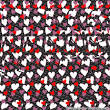Unveiling the Enchanting World of 3D Illusions
The Fascinating World of 3D Illusions
3D illusions, also known as three-dimensional illusions, are captivating visual phenomena that trick the eye into perceiving depth where there is none. These illusions create the illusion of depth on a flat surface, giving the impression that the image is three-dimensional and can be interacted with.
How Do 3D Illusions Work?
3D illusions rely on various visual cues such as perspective, shading, and colour to create the illusion of depth. By strategically manipulating these elements, artists and designers can craft images that appear to pop off the page or screen.
Types of 3D Illusions
There are several types of 3D illusions, including anamorphic illusions, stereograms, and autostereograms. Anamorphic illusions involve distorting an image so that it appears normal only when viewed from a specific angle or with a special device. Stereograms use subtle differences between two images to create a three-dimensional effect when viewed with both eyes. Autostereograms are single images that hide a three-dimensional scene within them, which can be revealed by focusing your eyes in a particular way.
The Impact of 3D Illusions
3D illusions have been used in art, entertainment, advertising, and even psychology to captivate audiences and convey messages in unique ways. They challenge our perception of reality and encourage us to see things from different perspectives.
Creating Your Own 3D Illusions
With advancements in technology and software tools, creating your own 3D illusions has become more accessible than ever. Whether you’re an aspiring artist or simply curious about the world of optical illusions, experimenting with creating your own three-dimensional artwork can be a rewarding and creative endeavour.
Explore the mesmerising world of 3D illusions and unleash your creativity through this innovative art form!
Exploring the Mysteries of 3D Illusions: Common Questions Answered
- What is a 3D image illusion called?
- Is the 3D world an illusion?
- How do you see a 3D illusion?
- What is a 3D illusion?
What is a 3D image illusion called?
A 3D image illusion is commonly referred to as a stereogram. Stereograms are visual images that use subtle differences between two slightly offset images to create the illusion of depth when viewed with both eyes. This technique tricks the brain into perceiving a three-dimensional effect, making stereograms a popular and intriguing form of optical illusion enjoyed by many enthusiasts and artists alike.
Is the 3D world an illusion?
The question of whether the 3D world is an illusion is a thought-provoking and philosophical inquiry that has intrigued minds for centuries. In the context of optical illusions and visual trickery, the 3D world can indeed be seen as an illusion created by our perception and interpretation of sensory information. While we perceive depth, distance, and spatial relationships in a three-dimensional manner, these perceptions are ultimately constructed by our brains based on the input received from our senses. This notion challenges us to contemplate the nature of reality, consciousness, and how we interact with the world around us through the lens of perception and interpretation.
How do you see a 3D illusion?
To perceive a 3D illusion, your brain relies on visual cues such as perspective, shading, and depth perception. When viewing a 3D illusion, these cues trick your brain into perceiving depth and dimension on a flat surface. By combining artistic techniques and optical illusions, creators manipulate these visual cues to create the impression of three-dimensional space within a two-dimensional image. This clever manipulation of visual elements allows viewers to experience the magic of 3D illusions and witness images seemingly come to life before their eyes.
What is a 3D illusion?
A 3D illusion, also known as a three-dimensional illusion, refers to a captivating visual phenomenon that creates the perception of depth on a flat surface. These illusions use clever techniques such as perspective, shading, and colour manipulation to trick the eye into seeing an image as if it has depth and dimensionality. By exploiting these visual cues, artists and designers can craft mesmerising visuals that appear to leap off the page or screen, offering viewers a unique and immersive viewing experience unlike traditional two-dimensional images.


